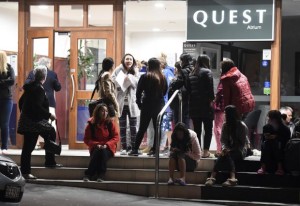2 die as powerful quake hits New Zealand, causing tsunami

People evacuated from the Quest On the Terrace Hotel gather outside the hotel in Wellington after a 6.6 earthquake based around Cheviot in the South island shock the capital, New Zealand, Monday, Nov. 14, 2016. A powerful earthquake struck New Zealand near the city of Christchurch early Monday (early evening Sunday Philippine time), with strong jolts causing some damage to buildings over 200 kilometers (120 miles) away in the capital, Wellington. —ROSS SETFORD/SNPA via AP
(UPDATED: 2:54 a.m., Nov. 14, 2016)
WELLINGTON, New Zealand — At least two people were killed in the powerful earthquake that struck New Zealand, Prime Minister John Key said at a news conference on Monday morning in Wellington, the capital.
Key added that earlier tsunami warnings were being downgraded to coastal warnings.
Authorities said they were not yet declaring a national emergency, saying the regions are coping well.
A powerful 7.8 magnitude earthquake rocked New Zealand’s South Island early Monday, the US Geological Survey said, shaking awake residents, causing damage to buildings and prompting emergency services to warn people along the coast to move to higher ground to avoid tsunami waves.
Article continues after this advertisementThe magnitude-7.8 earthquake struck some 93 kilometers north of a mostly rural area close to the city of Christchurch. But it appeared to be more strongly felt in the capital, Wellington, more than 200 kilometers (120 miles) away. The quake was followed by a number of strong aftershocks.
Article continues after this advertisementChristchurch was devastated five years ago by a 6.3 tremor which killed 185 people in one of New Zealand’s deadliest disasters.
Monday’s quake knocked out New Zealand’s emergency call number, 111, for about 10 minutes, police reported. It caused items to fall from shelves and windows to break in Wellington, and forced hundreds of tourists onto the streets as hotels were evacuated.
New Zealand’s Ministry of Civil Defence and Emergency Management reported that a tsunami wave struck at about 1:50 a.m. (8:50 p.m. Sunday in the Philippines) and warned residents living in low-lying areas anywhere along the country’s east coast to move to higher ground.
The ministry had earlier sent out a message on Twitter saying there was no tsunami threat to the country. But then it sent out another message — “situation has changed – tsunami is possible” – before reporting that a tsunami had, in fact, hit.
The Pacific Tsunami Warning Center said there was no immediate danger of a broader tsunami from the quake.
There were no immediate reports of any major damage or injuries in Christchurch.
The quake, initially put at 7.4 but later upgraded, struck at 12:02 a.m. (1102 GMT Sunday, 7:02 p.m. Sunday Philippine time). It was only 10 kilometers deep and felt throughout most of the country.
In Wellington, 214 kilometers (132 miles) north of the quake’s epicenter, power was knocked out in some places, and some windows smashed and some chimneys collapsed.
The main tremor was followed by a series of strong aftershocks and there were reports of damaged buildings in the small rural township of Cheviot near the epicenter.
‘Massive and really long’
“It was massive and really long,” Tamsin Edensor, a mother of two in Christchurch, told AFP, describing the powerful quake as the biggest since the deadly 2011 tremor.
“We were asleep and woken to the house shaking, it kept going and going and felt like it was going to build up.”
In a brief message the Prime Minister John Key tweeted: “I hope everyone is safe after the earthquake tonight.”
The ambulance service said it did not receive any reports of quake-related injuries.
Anna Kaiser, a seismologist with the GNS Science, said the government’s earthquake monitoring service, the quakes were close to the coast.
“They’ve been quite large. We’ve also seen a signal on the tide gauge at Kaikoura which is up to one metre (three feet) so it’s reasonably significant, so people should take this seriously.”
‘Just really shaken’
As Monday’s quake hit, Christchurch resident Hannah Gin had just sat down in her living room to watch a replay of this weekend’s All Blacks versus Italy rugby match when her house started shaking. Upstairs, her mother let out a scream.
Gin, a 24-year-old lifelong Christchurch resident, is accustomed to quakes, so she said she sat calmly and waited, figuring the rumbling would stop in a few seconds. Instead, the shaking just went on and on — for at least three minutes, according to the clock on her phone, she said by phone.
The quake was far less violent than the one that struck her city in 2011, Gin said, adding that there was no jarring up and down or side to side, just a long, rolling sensation. But it went on for much longer than the typical quakes that strike the area, she said. She was less concerned about running for cover than she was about vomiting from the motion sickness, she said with a chuckle.
“I could hear the sliding door sliding back and forth and we’ve got washing hanging up and I could see the washing moving,” Gin said. “It just kept going and going.”
Her house, which was damaged in the 2011 quake, did not appear to have sustained any new damage from Monday’s quake, she said. She said she had heard from many of her friends who live in the city, and all were safe.
“As far as I know, everyone’s fine,” she said. “We’re all just really shaken.”
In September, a strong 7.1-magnitude earthquake struck the east coast of New Zealand, generating a small tsunami, but no significant damage or injuries were reported.
New Zealand is on the boundary of the Australian and Pacific tectonic plates, which form part of the so-called “Ring of Fire,” and experiences up to 15,000 tremors a year. —Reports from AP and AFP